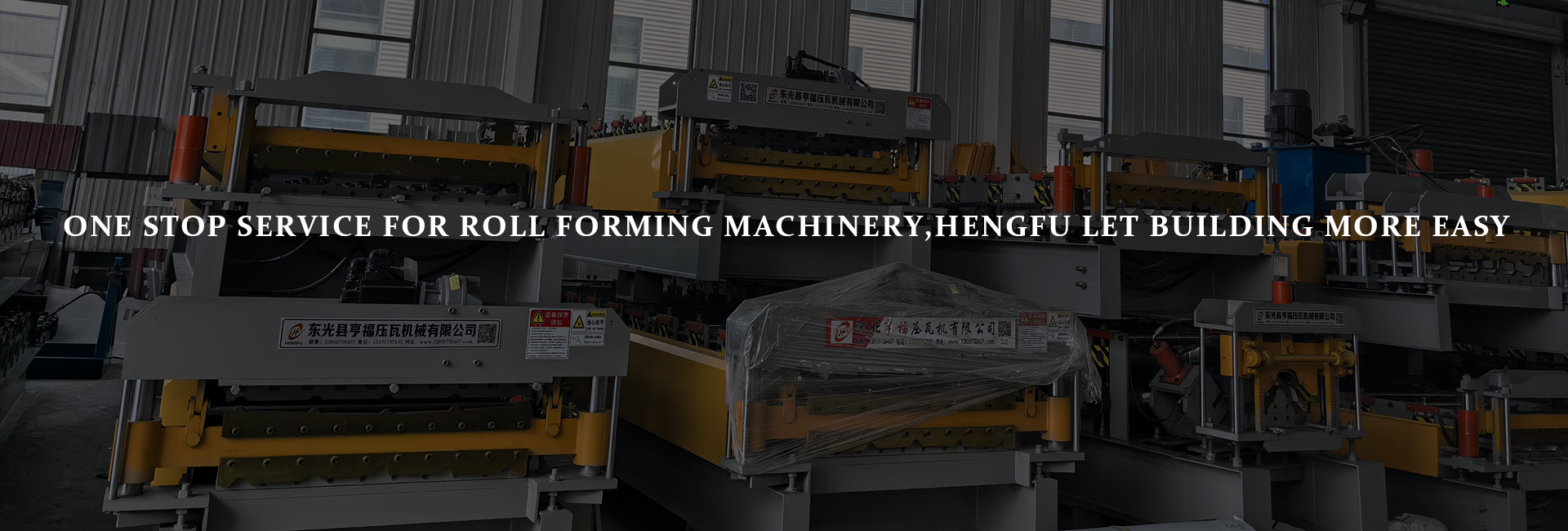In the current booming construction industry, roof panel forming machines, as key equipment for metal roofing production, have garnered significant attention regarding their price fluctuations. Understanding the factors behind these price changes is a crucial prerequisite for purchasers to make informed decisions. This article will delve into the price fluctuation factors of roof panel forming machines based on the industry characteristics of these devices, combining principles of equipment operation and market environment, to provide professional references for your procurement.
1. Introduction: The Industry Value of Metal Roof Forming Machines
1.1 Market Growth Trends of Metal Roofs and the Need for Construction Efficiency
With the continuous emergence of industrial plants, commercial buildings, and other projects, metal roofs have seen a sustained increase in market demand due to their lightweight, durability, and ease of installation. To meet large-scale and high-precision construction requirements, roof panel forming machines have become core equipment for enhancing production efficiency, with their importance becoming increasingly prominent.
1.2 Traditional Construction Pain Points vs. the Core Advantages of Forming Machines
Traditional metal roofing construction suffers from issues such as low production efficiency, high labor costs, and unstable forming precision. Roof panel forming machines effectively address these pain points through automated production and high-precision processing, significantly improving construction efficiency and quality while reducing overall costs.
1.3 Core Focus of This Article: Equipment Analysis and Efficiency Enhancement Paths
This article focuses on the price fluctuation factors of roof panel forming machines, combining basic equipment knowledge with efficiency enhancement mechanisms to analyze the logic behind price changes for purchasers, providing scientific procurement strategies.
2. Basic Understanding of Metal Roof Forming Machines
2.1 Equipment Definition and Functional Overview
Roof panel forming machines are specialized devices that process metal sheets into roof panels of specific shapes through rolling processes. They can automate the conveyance, profiling, and cutting of sheets, widely applied in metal roofing construction for various buildings, serving as important equipment for industrialized production.
2.2 Core Components
Rolling System: Composed of multiple sets of rollers, it gradually deforms metal sheets into the desired shape. The quality and precision of the rolling system directly affect the forming results.
Transmission Device: Provides power for equipment operation, including components such as motors, gears, and chains. A stable transmission system is crucial for the efficient operation of the equipment.
Control System: Responsible for setting operational parameters and monitoring equipment status. Intelligent control systems also possess fault diagnosis and automatic adjustment functions.
2.3 Classification of Mainstream Models
By Number of Layers: Divided into single-layer and double-layer forming machines. Single-layer machines produce one type of panel at a time, while double-layer machines can quickly switch between two types, meeting diverse production needs.
By Degree of Automation: There are semi-automatic and fully automatic forming machines. Semi-automatic machines require manual assistance, while fully automatic machines can achieve full-process automation, offering higher production efficiency.
2.4 Technical Parameter Analysis Directions
Forming Speed: Reflects the equipment's output per unit time. A faster speed indicates higher production efficiency but also places higher demands on equipment performance.
Sheet Material Applicability: Covers the range of sheet materials (such as color-coated steel sheets, aluminum-magnesium-manganese alloy sheets) and thicknesses. A wider applicable range enhances the equipment's versatility.
Precision Indicators: Such as dimensional errors and surface flatness. High-precision equipment typically commands higher prices but ensures construction quality.
3. Analysis of Price Fluctuation Factors for Roof Panel Forming Machines
3.1 Differences in Equipment Types and Configurations
Prices vary significantly among different types of roof panel forming machines. Fully automatic and double-layer forming machines, due to their more complex functions and higher degrees of automation, generally command higher prices than semi-automatic and single-layer models. Additionally, the configuration of core components, such as high-precision rollers, intelligent control systems, and high-performance motors, directly impacts prices. Higher configurations lead to increased costs and correspondingly higher selling prices.
3.2 Fluctuations in Raw Material Prices
The production of roof panel forming machines relies on raw materials such as steel and electronic components. Steel prices are influenced by market supply and demand, macroeconomic policies, and other factors. If steel prices rise, the production costs of equipment increase, driving up the overall prices. Electronic component prices also fluctuate due to technological updates and market monopolies, affecting equipment prices.
3.3 R&D and Innovation Investments
To enhance product competitiveness, enterprises continuously invest in R&D and innovation. Equipment equipped with advanced technologies, such as intelligent control, energy-efficient designs, and multi-specification sheet compatibility, incurs high R&D costs, resulting in higher prices compared to ordinary models. The application of new technologies not only improves equipment performance but also increases product value-added.
3.4 Changes in Market Supply and Demand
When market demand for roof panel forming machines is strong and supply is relatively insufficient, equipment prices tend to rise. Conversely, if market competition is intense and supply exceeds demand, enterprises may lower prices to capture market share. Additionally, regional market supply and demand imbalances can also lead to price differences, with prices being higher in regions with concentrated demand but limited supply.
3.5 Brand and After-Sales Service Costs
Well-known brands have advantages in product quality, technological strength, and market reputation. Consumers have a high degree of recognition for these brands and are willing to pay a premium. Meanwhile, high-quality after-sales services, including installation and commissioning, personnel training, regular maintenance, and rapid repair responses, also increase enterprise operating costs, which are reflected in equipment prices.
4. Recommendations for Selection and Use
4.1 Selecting Models Based on Project Scale
Small-Scale Projects: For projects with small construction volumes and single panel types, semi-automatic single-layer forming machines can be chosen due to their lower prices and ability to meet basic production needs.
Large-Scale Projects: For large-scale, multi-panel-type projects, fully automatic double-layer forming machines are recommended. Although their prices are higher, their production efficiency and functionality offer better value for money in the long run.
4.2 Rational Consideration of Brand and Price
When selecting equipment, one should not solely rely on brand recognition to choose high-priced devices or pursue low prices at the expense of product quality. A comprehensive assessment of brand reputation, product performance, and after-sales services should be conducted to select cost-effective equipment.
4.3 Monitoring Raw Material Market Dynamics
Since raw material prices significantly impact equipment prices, purchasers can monitor market dynamics for steel, electronic components, etc., and choose to purchase during periods of lower raw material prices to reduce costs.
4.4 Emphasizing Long-Term Usage Costs of Equipment
In addition to the procurement price, factors such as energy consumption, maintenance costs, and service life of the equipment should be considered for long-term usage costs. Choosing energy-efficient and easy-to-maintain equipment may involve higher initial investments but can reduce overall costs in the long term.
5. Industry Trends and Future Prospects
5.1 Impact of Intelligent Upgrades on Price Trends
With the application of intelligent technologies such as AI regulation and remote monitoring in roof panel forming machines, equipment functions become more comprehensive, and performance is significantly enhanced. The high R&D and production costs of intelligent equipment lead to correspondingly higher prices. However, the growing market demand for intelligent equipment may drive adjustments in the overall price structure of the industry.
5.2 Cost Changes Triggered by Green and Environmentally Friendly Technologies
The application of green and environmentally friendly technologies, such as energy consumption optimization and material recycling, in equipment increases enterprise R&D and production costs. However, in the long run, equipment that meets environmental requirements is more favored by the market. Enterprises may reduce costs through technological innovations and scale effects, thereby influencing price fluctuations.
5.3 Adjustments in Pricing Strategies Driven by Market Competition
Intensified market competition will prompt enterprises to continuously optimize their products and pricing strategies. Enterprises may improve production efficiency and reduce costs through technological innovations to launch more price-competitive products. Alternatively, they may create high-end products through differentiated competition to capture higher profit margins.
6. Conclusion: Equipment Empowering Construction Transformation
The prices of roof panel forming machines are influenced by multiple factors. Gaining an in-depth understanding of these factors before procurement helps in making scientific and rational purchasing decisions. By selecting appropriate equipment, not only can project production needs be met, but enterprises can also reduce costs and enhance efficiency, driving transformation and development in the construction industry. If you wish to further explore equipment selection and procurement details, welcome to explore more professional content and embark on an efficient procurement journey.







